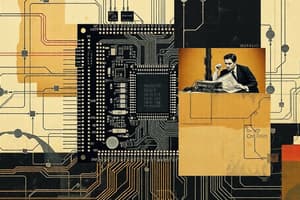Podcast
Questions and Answers
What is the primary function of the instruction register (IR) in a CPU?
What is the primary function of the instruction register (IR) in a CPU?
- To permanently store program codes
- To hold instructions fetched from memory for decoding (correct)
- To store binary data from memory
- To track the next memory address
Which type of memory can be programmed and has its contents altered by shining ultraviolet light?
Which type of memory can be programmed and has its contents altered by shining ultraviolet light?
- RAM
- ROM
- EPROM (correct)
- EEPROM
What characteristic differentiates ROM from RAM?
What characteristic differentiates ROM from RAM?
- RAM holds data permanently, while ROM does not
- RAM is slower than ROM in data access
- ROM can be written to and erased, while RAM is read-only
- ROM cannot be written into after manufacture, while RAM is temporary (correct)
How is data stored in the memory unit identified?
How is data stored in the memory unit identified?
Which mechanism is used by EEPROM to erase data?
Which mechanism is used by EEPROM to erase data?
What defines an open loop control system?
What defines an open loop control system?
What does the program counter (PC) track?
What does the program counter (PC) track?
Which characteristic applies to random-access memory (RAM)?
Which characteristic applies to random-access memory (RAM)?
Flashcards
Program Counter (PC)
Program Counter (PC)
This register holds the next instruction's memory address to be executed in a program.
Instruction Register (IR)
Instruction Register (IR)
This register temporarily stores an instruction fetched from memory, allowing the CPU to decode and execute it.
Read-Only Memory (ROM)
Read-Only Memory (ROM)
A type of memory where data is stored permanently. It's programmed during manufacturing and cannot be altered.
Erasable Programmable Read-Only Memory (EPROM)
Erasable Programmable Read-Only Memory (EPROM)
Signup and view all the flashcards
Electrically Erasable Programmable Read-Only Memory (EEPROM)
Electrically Erasable Programmable Read-Only Memory (EEPROM)
Signup and view all the flashcards
Random Access Memory (RAM)
Random Access Memory (RAM)
Signup and view all the flashcards
Open Loop Control System
Open Loop Control System
Signup and view all the flashcards
Memory Unit
Memory Unit
Signup and view all the flashcards
Study Notes
Mechatronics Engineering (OFRME200) Lecture 10
- Course Level: 2, Fall Semester
- Instructor: Walaa Shoeib
- University: Menoufia University, Faculty of Electronic Engineering
Chapter 5: Microcontroller Structure
- This chapter focuses on the structure of microcontrollers.
Registers
- Instruction Register (IR): Stores an instruction after fetching it from memory. CPU stores the instruction into the IR. Decoding and execution of the operation follows.
- Program Counter (PC): A special register keeping track of the memory address of the next instruction to be executed in a program.
- Memory Unit: Contains the program counter, instruction register, memory address register, and accumulator register.
- Control Unit (CU): Executes the instructions stored in the IR.
- Arithmetic and Logic Unit (ALU): Performs arithmetic and logical operations.
- Data Bus: Carries data between components.
- Address Bus: Carries the memory address to be accessed.
- Control Bus: Carries control signals to coordinate operations between components.
Memory
- Memory Unit: Stores binary data. Data can be program instruction codes or numbers to be operated on.
- Memory Size: Determined by the number of wires in the address bus.
- Memory Element: A unit consisting of many storage cells. Each cell can store a 0 or a 1 bit.
- Memory Locations: Cells grouped into locations; each storing one word.
- Address: Unique identifier for each location used to access the stored word.
Types of Memory
- ROM (Read-Only Memory): Permanent storage for data programmed during manufacturing. Data cannot be written to it.
- PROM (Programmable ROM): Can be programmed once, but cannot be erased.
- EPROM (Erasable Programmable ROM): Programmable and erasable, erased by UV light.
- EEPROM (Electrically Erasable Programmable ROM): Programmed and erased electrically.
- RAM (Random-Access Memory): Temporary storage for data currently being operated on. Data can be readily read and written.
Read-Only Memory (ROM)
- ROM stores data permanently.
- ROMs are pre-programmed at manufacturing.
- Data can only be read from a ROM.
Erasable and Programmable ROM (EPROM)
- EPROM is programmable and erasable.
- Patterns can be altered.
- Erasure is accomplished by shining UV light on the device.
Electrically Enable PROM (EEPROM)
- EEPROM is similar to EPROM.
- Erasure is achieved by applying high voltage instead of UV light.
Random-Access Memory (RAM)
- RAM stores temporary data for processes.
- It can store and retrieve data very quickly.
Open Loop Control System
- Output depends solely on the input, without feedback.
- Control device directly affects the actuator.
- No feedback loop.
- Simple and cost-effective; however, cannot adjust the output.
Closed Loop Control System
- Also called feedback control system.
- Incorporates an input, a forward path, and a feedback path, enabling feedback.
- Detects actual output and adjusts it.
Component of Mechatronics System
- Actuators: (e.g., solenoids, DC motors, stepper motors, servo motors, hydraulics, pneumatics.)
- Mechanics and Energy Converter: (e.g., mechanical, hydraulic, thermal, electrical)
- Sensors: (e.g., switches, potentiometers, photoelectric sensors, digital encoders, strain gauges, thermocouples, accelerometers, MEMS)
- Input Signal Conditioning and Interfacing: (e.g., discrete circuits, amplifiers, filters, analog-to-digital (A/D) and digital-to-analog (D/A) converters)
- Output Signal Conditioning and Interfacing: (e.g., amplifiers, D/A converters, PWM, power op amps)
- Graphical Displays: (e.g., LEDs, digital displays, LCDs, CRTs)
- Digital Control Architectures: (e.g., logic circuits, microcontrollers, PLCs, sequencing and timing, logic and arithmetic control algorithms, communication)
Studying That Suits You
Use AI to generate personalized quizzes and flashcards to suit your learning preferences.
Related Documents
Description
This quiz covers the structure of microcontrollers as discussed in Chapter 5 of the Mechatronics Engineering course. Key components such as the instruction register, program counter, and control unit are examined. Perfect for those looking to reinforce their understanding of microcontroller architecture.




